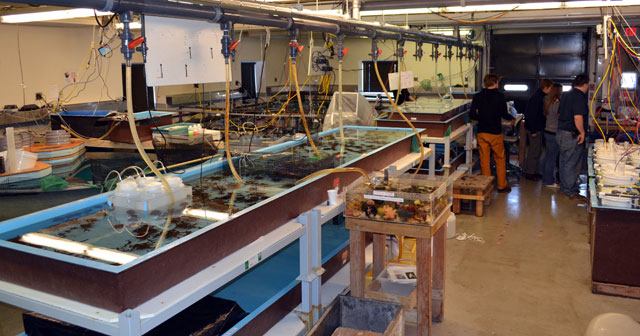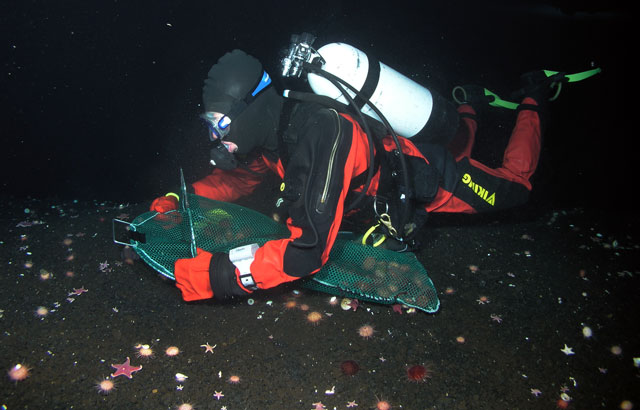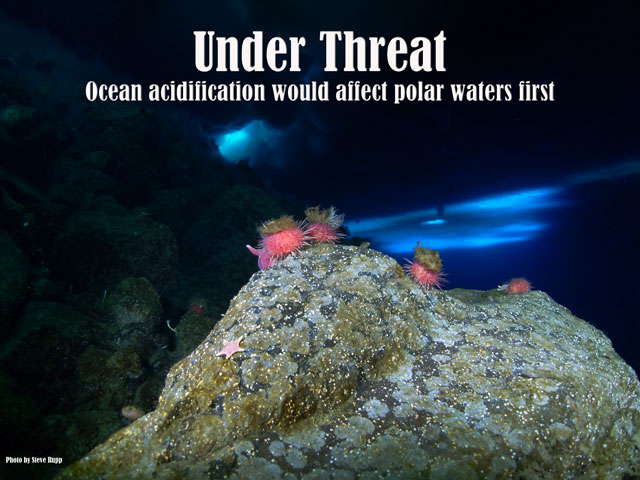Baseline studyResearch on Antarctic sea urchins makes first long-term measurement of ocean pHPosted April 6, 2012
Talk about a bad acid trip. By the end of the 21st century, if humans keep pumping carbon dioxide (CO2) into the atmosphere as prodigiously as recent decades, the world’s oceans may become a very inhospitable place for shell-building organisms, starting with the polar regions. That has drawn a team of researchers to McMurdo Station “We didn’t know what the tolerances of marine invertebrates would be because the way they’re stereotyped is that they have a very narrow ocean temperature and chemistry range, so we wanted to explore that in the lab,” explained Gretchen Hofmann “They’re a little more resilient than we thought,” she added. At least based on the first battery of experiments by the researchers, who spawn the critters in McMurdo’s laboratory aquarium for various experiments that mimic high levels of atmospheric CO2 on seawater. Sea urchins and many other marine invertebrates, from corals to clams, use the calcium carbonate minerals of calcite or aragonite to construct their shell coverings or skeletons. This requires supersaturating concentrations of the carbonate ion in seawater. Normally that’s not a problem. However, it turns out that oceans serve as a great sink for CO2, absorbing up to a third of it from the atmosphere. But it comes at a cost by altering the seawater chemistry and turning it more acidic. As ocean pH falls, so does the concentration of the carbonate ion. The pH level, measured in units, is a calculation of the balance of a liquid’s acidity and alkalinity. The lower a liquid’s pH number, the higher its acidity. The worse case scenarios for future CO2 levels by the year 2100 translate to dangerously low pH levels, according to the 2007 Intergovernmental Panel on Climate Change (IPCC) 
Photo Credit: Peter Rejcek
The Crary Lab aquarium hosted two ocean acidification projects last season.
The spiky sea urchin found on the seafloor around Antarctica might be one of the first organisms to feel the effects of ocean acidification due to the cold polar waters in which it lives. That’s because CO2 more readily dissolves in colder water, meaning polar oceans would acidify first. And there’s already evidence that the open ocean pH has dropped. Before the Industrial Revolution, ocean pH was nearly 8.2. It has dropped to about 8.1. At the end of the 21st century, under the “business as usual” model of burning fossil fuels at current rates, the IPCC report says the pH could plunge down to 7.8, which many researchers consider a threat to marine life. In fact, research led by scientists at Stanford University However, there are still many uncertainties surrounding ocean acidification. Researchers have only really begun to test how different marine organisms may respond to higher acidity. An even bigger unknown is the exact pH of the ocean in different regions around the world. That 8.1 pH number is just a rough estimate. Principal investigator on the Antarctic sea urchin project, Hofmann is also collaborating on more broad-scale studies, including another National Science Foundation She was also the lead author of a paper published late last year in the journal PLoS ONE that monitored the pH levels at 15 locations around the world, including seawater in the Antarctic, as well as temperate locations and the deep ocean. “We were able to illustrate how parts of the world’s oceans currently have different pH, and thus how they might respond to climate changes in the future,” Hofmann had explained in a press release from UCSB.1 2 Next |



For USAP Participants |
For The Public |
For Researchers and EducatorsContact UsU.S. National Science FoundationOffice of Polar Programs Geosciences Directorate 2415 Eisenhower Avenue, Suite W7100 Alexandria, VA 22314 Sign up for the NSF Office of Polar Programs newsletter and events. Feedback Form |



